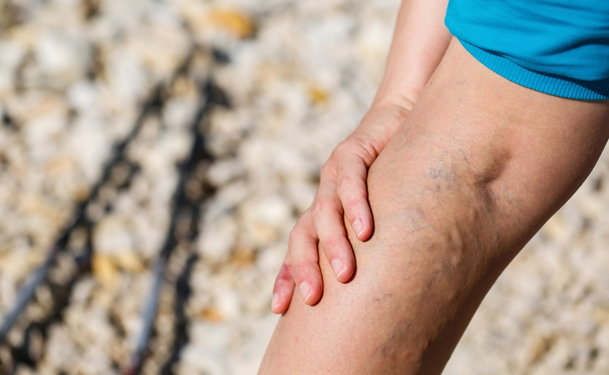Painful veins represent a symptom of several medical conditions that range from cosmetic problems to medical emergencies. It is a common symptom in the legs that sometimes occurs along with varicose or spider veins.
The pain may appear as a dull ache or something more severe. Other times, it can show up as itching around one or more of the veins. The pain may also be constant or grow worse after sitting or standing for a long time.
Causes of Painful Veins
Varicose veins and spider veins are swollen veins caused by a weakening of the blood vessel wall. Varicose veins and spider veins appear to be blue or dark purple in color and look twisted or bulging. They can develop in any part of the body but are most common in the legs and feet. Varicose veins—and the milder spider veins—are often just a cosmetic problem. In some cases, though, they may also cause itching or aching pain.
Chronic venous insufficiency is a condition caused by a problem with the valves and vein walls. Normally, the valves keep the blood from flowing backwards. When they don’t work properly, blood pools inside the veins instead of flowing to the heart. This condition, known as venous reflux, can cause pain in the legs as well as varicose veins on the surface of the legs.
Deep vein thrombosis (DVT) is a serious condition where a blood clot forms inside a deep vein. These can form anywhere in the body but most often occur in the thigh or lower leg. DVT can cause pain in the affected area of the body. The blood clot can also prevent the blood from flowing properly, leading to swelling of the vein (thrombophlebitis). If a DVT breaks loose from the wall of the vein, it can also end up in the lung and cause a pulmonary embolism, which is a medical emergency that can result in a fatality.
Cellulitis is a common bacterial infection of the skin. Although it involves the skin and not the veins, it may produce symptoms similar to DVT, such as pain, swelling and warmth in the part of the body that is affected. In addition, certain health problems such as poor drainage of the veins or varicose veins may increase your risk of bacteria entering through a break in the skin. If left untreated, cellulitis can become a life-threatening illness.
Superficial thrombophlebitis is inflammation of a vein due to a blood clot. The vein is located just below the surface of the skin (superficial). This condition can cause pain along the vein, along with redness or tenderness of the area. Superficial thrombophlebitis can happen after the vein is injured or an intravenous (IV) line or catheter is inserted into the vein. Certain things increase your risk of developing this condition, such as infection, sitting still for a long time and varicose veins.
Treatment Options
The treatment options for painful veins depend upon the underlying conditions. Because each condition may be treated differently, it is important that you visit a doctor and find out exactly what is causing the pain.
For varicose veins and spider veins, several treatments are available, including:
- Self-care - Several lifestyle changes may reduce pain from varicose veins and may prevent them from worsening, such as losing weight, adopting a healthy diet, exercising regularly, avoiding sitting or standing for long periods and elevating your legs frequently.
- Compression stockings - By squeezing your legs, these stockings help your veins move blood more easily toward your heart.
- Sclerotherapy - During this procedure, your doctor will inject a special solution into the varicose veins. This causes them to scar and close. The blood will then flow to other, healthier veins. This may require several sessions.
- Laser surgery - Strong bursts of light are used to close off smaller varicose veins and spider veins. This avoids the need for needles or injections.
- Vein stripping - During this treatment a surgeon removes a long vein through small incisions in the skin. After the procedure, the blood will flow to other veins in the leg, especially those deep inside the leg.
- Ambulatory phlebectomy - Your doctor will make a series of tiny punctures in your skin and then remove small varicose veins through these holes.
- Endoscopic vein surgery - This procedure is used for more severe cases of varicose veins, such as when you have developed ulcers on your leg. During the procedure, you doctor will insert a tiny video camera into your leg. The varicose veins are then removed through small cuts in the skin.
Each treatment for varicose veins, and for other conditions that cause painful veins, has its own side effects. Ask your doctor about these before agreeing to any treatment. That way, you will be able to determine if the benefits outweigh any risks.


